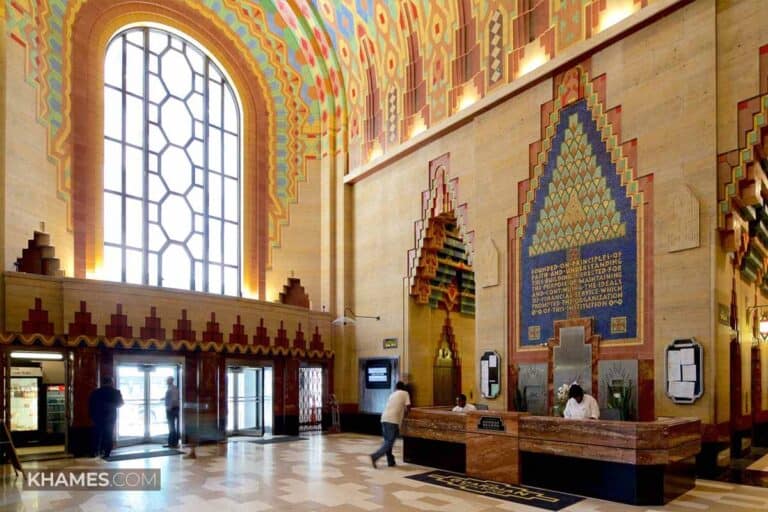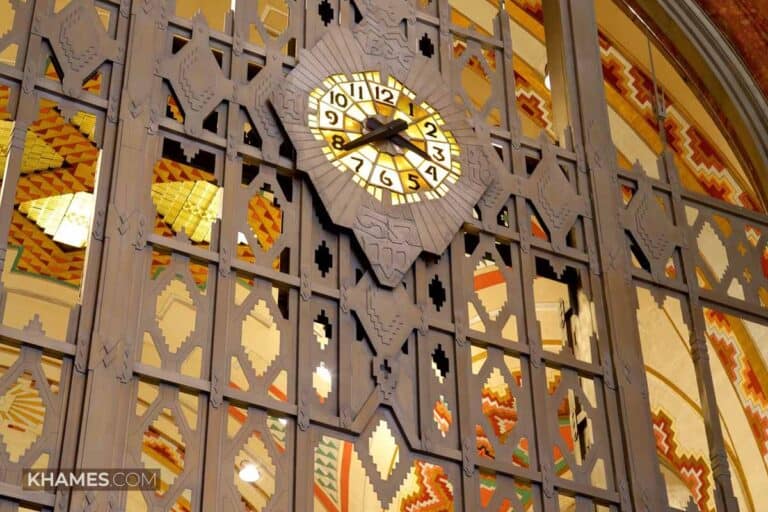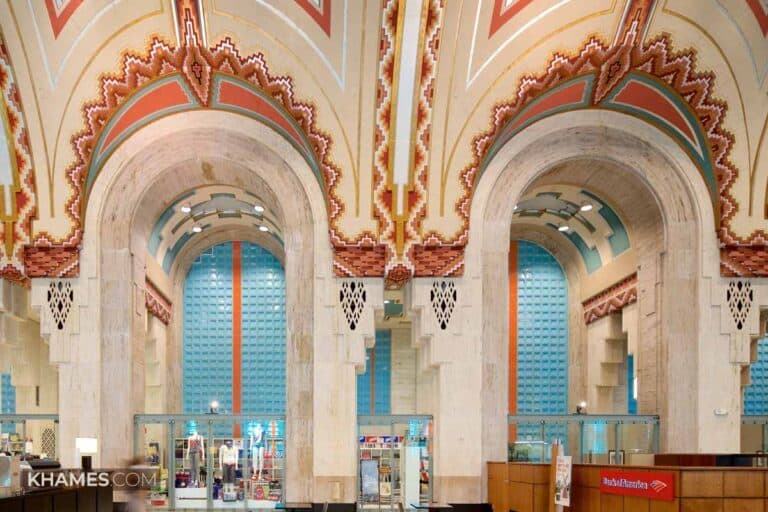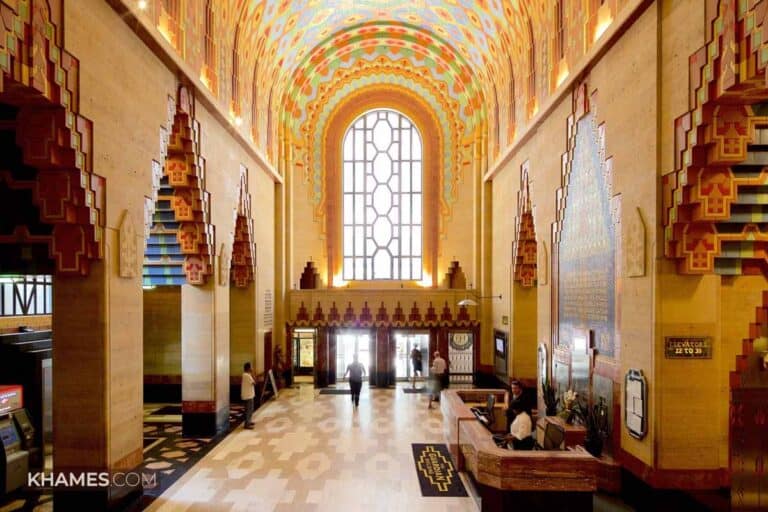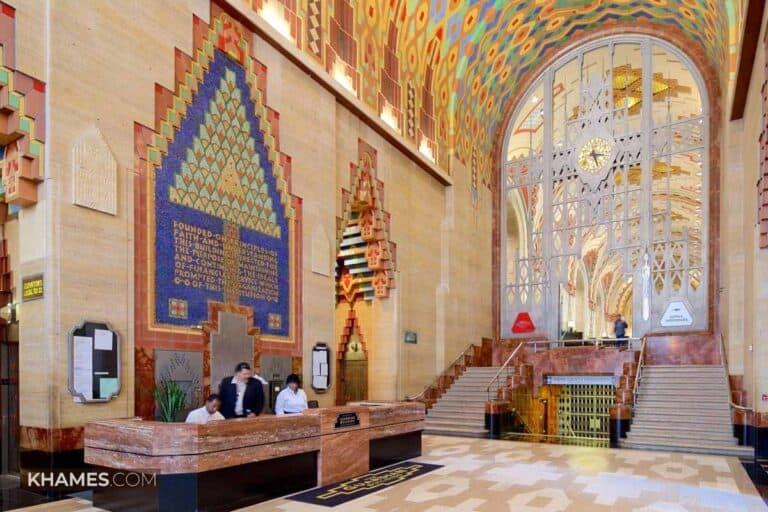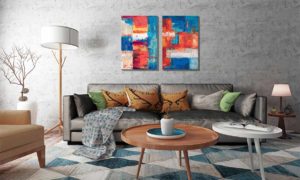Welcome to the fascinating world of Art Deco style on architecture, interior design, and furniture, which characterized by its bold geometric forms, rich colors, and lavish ornamentation from the twenties through to the thirties.
As we delve into this captivating style, we uncover how Art Deco’s influence transcends time to remain as compelling today as when it first emerged on the world stage.
Discovering the Birthplace of Art Deco
Art Deco, a term that conjures images of glamour, luxury, and symmetrical designs, was not merely an artistic movement but a celebration of modernity and sophistication in the aftermath of World War I.
This design ethos emerged in the early 1920s in France, where it initially dazzled society with its innovative approach to art and architecture before sweeping across continents.
The style was actually named after the Exposition “Internationale des Arts Décoratifs et Industriels Modernes” held in Paris in 1925, which showcased this new aesthetic that married functionality with elegance.
Unlike other movements that evolved gradually over time, Art Deco announced itself to the world on this grand stage, setting a precedent for interior designs that prioritized opulent finishes and geometric clarity.
Incorporating the Allure of Geometry and Symmetry
At the heart of Art Deco interior design lies an unwavering commitment to symmetry and geometry.
This style elevates rooms from mere living spaces to sophisticated galleries, showcasing sharp lines, angular patterns, and a harmony that is as pleasing to the eye as it is thought-provoking.
Think ziggurat (stepped) shapes, chevron patterns, and sunburst motifs – these were not merely decorative flourishes but emblematic representations of the era’s fascination with progress, speed, and the dawn of industrialization.
Incorporating these geometrical elements into modern spaces can be both subtle or bold; consider a geometric pattern wallpaper for a striking statement wall or select streamlined furniture that echoes these shapes for a more understated homage.
Art Deco in Architecture
Art Deco in architecture speaks to the soul of modernity, embodying an era when innovation dared to blend with luxury.
This architectural style, flourishing in the 1920s and 1930s, can be likened to a bold experiment wherein architects threw caution to the wind, injecting buildings with geometric forms and exotic motifs.
It’s as if these structures were intended not just for their time but also envisioned as monuments of the future – a bridge between ages where functionality met opulence.
The allure of Art Deco lies in its unique ability to capture speed, power, and progress in concrete forms.
Imagine skyscrapers like New York’s Chrysler Building reaching skyward with its gleaming spire; or Miami’s pastel-hued hotels that seem to dance under the sun – these are not merely constructions but declarations of humanity’s boundless ambition.
Through terracotta reliefs inspired by ancient civilizations or chrome finishes reflecting industrial prowess, Art Deco whispers tales of human dreams daringly pursued amidst steel beams and stucco facades.
Every element serves a narrative purpose far beyond mere decoration — it encapsulates an age striving boldly towards tomorrow.
What is Art Deco in interior design
Art Deco in interior design encapsulates a timeless elegance that has managed to leap across decades unscathed by the whirlwind of changing tastes.
This movement, spearheaded in the roaring twenties, intertwines luxury with functionality, bringing forth an aesthetic that dazzles with geometric patterns, sleek lines, and a sprinkle of metallic finishes.
It’s a style where opulence meets industrial-age innovation, creating spaces that are as glamorous as they are forward-thinking.
At its heart, Art Deco in interior design is not just about the bold statement pieces; it’s about crafting environments where every element harmonizes to evoke sophistication and comfort.
From the sunburst motifs gracing mirrors to the lavish use of velvets and silks, this style beckons us to reimagine our living spaces as canvases for artistic expression.
By embracing Art Deco, homeowners embark on a journey back in time while anchoring themselves firmly in modern luxury—a unique blend that continues to captivate imaginations today.
Art Deco in Furniture
Art Deco in furniture is not just a style; it’s an eclectic mix of geometric shapes, rich materials, and exquisite craftsmanship.
This unique blend catapults it beyond mere decorative art into a timeless expression of elegance and modernity.
Beyond aesthetics, Art Deco in furniture symbolizes a revolutionary shift towards modernism—where function began to marry form in unprecedented ways.
It’s intriguing how this style encapsulated the optimism of the early 20th century while embracing technological advancements and cultural amalgamations from across the globe.
The use of innovative materials such as aluminium, stainless steel alongside exotic woods and lacquer work bring out an understated luxury that manages to captivate without overwhelming.
Thus inviting us to reimagine our living spaces as canvases for creativity and individual expression through timelessly elegant pieces that transcend generational trends.
Conclusion
In conclusion, Art Deco stands as a timeless aesthetic that encapsulates the optimism, technological advancement, and cultural dynamism of the early 20th century. Its influence is evident in architecture, fashion, and design across the globe, seamlessly blending functionality with elegance.
As we continue to navigate through an ever-evolving modern landscape, Art Deco reminds us of the importance of marrying aesthetics with innovation. Its enduring legacy invites contemporary artists and designers to draw inspiration from its rich visual vocabulary.
Let us honor this remarkable style by preserving its iconic monuments and infusing its distinctive elegance into our creative endeavors, ensuring that the spirit of Art Deco continues to inspire generations to come.

